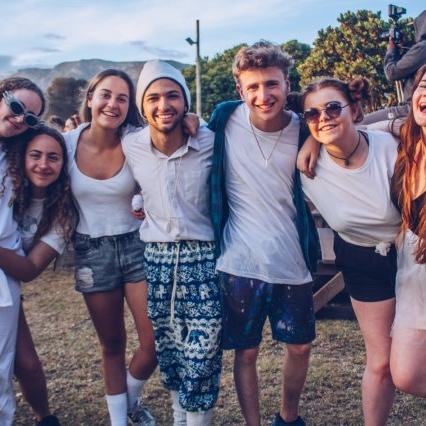click to dowload our latest edition
CLICK HERE TO SUBSCRIBE TO OUR NEWSLETTER


Published
5 years agoon
By
adminJULIE LEIBOWITZ
These children, who are in Grade 10, hail from 11 different kibbutzim close to the Gaza border.
“It’s a wonderful opportunity for these kids, who have been subjected to the constant attacks and endured trauma for most of their lives, to have the opportunity to travel to South Africa and be part of the Habonim experience,” says Habonim South Africa Shaliach Danny Adeno Abebe.
“More than 50 agricultural communities, most of them kibbutzim, dot Israel’s 51km border on the east and north of the Gaza strip. Some of them sit right on the edge, where they have little to no warning of Hamas rocket and mortar fire [at best warning sirens give them 15 seconds to find shelter]. They are also in easy range of the flaming kites that have destroyed thousands of hectares of agricultural fields and nature reserves over the past two months.
“These children are living under constant threat. It is something that our South African kids have no understanding of. Their stories need to be heard, and we feel that it would be both beneficial to South African kids as well as the Israelis to meet and interact with one another through the camp experience.”
Habonim Dror South Africa is bringing them out for 10 days at camp to give them a break from the enduring conflict in the region. It is also meant to promote integration and learning in South Africa.
The trip forms part of the South African Zionist youth movement’s tradition of reaching out to kids beyond South Africa’s borders to further Jewish and Zionist identity. It is funded by Habonim South Africa, World Habonim Dror, and the World Zionist Organisation.
It is being organised in memory of the late Gideon Prodgers, a 19-year-old Cape Town Jewish boy who died 10 years ago of cancer while on a gap-year with Habonim Dror in Israel.
“Gideon was the most amazing child,” says Shiri Madar, the Chief Executive of World Habonim Dror. “As we are bringing the children out on Chanukah, we are calling it ‘Light to Light’ in recognition of the support communities can give each other.”
Habonim’s end-of-year camp has always been available to children who live in African countries north of South Africa’s borders. This tradition continues, in spite of the challenges caused by emigration from countries like Zimbabwe, and a lack of support in some countries.
In addition, every year, children from countries like the United Kingdom, the United States, and Australia go to Habonim camp in Hermanus. “Normally, we get about 12 international kids,” says Habonim South Africa Manhig (Honourary President) Errol Anstey, “but this year’s intake is particularly high, at about 20.”
He says these children’s parents are mostly South African expats who have emigrated, and want their children to have the same experience they had.
“As an Israeli, and an African, these initiatives are close to my heart,” says Abebe, pointing out that making Habonim accessible to international chanichim (campers) helps to promote Zionist identity, and enrich the camp experience for South African youth.
Abebe himself hails from Ethiopia, and made the journey to Israel as a small child in 1984 in the mass exodus of Ethiopian Jews known as “Operation Moses”.
Abebe points out that it is not just an important gesture of support for these communities, it offers an ideal opportunity for cultural exchange and learning.
Gili Sayag, a co-ordinator in Israel’s Leisure and Community Department, who lives on Kibbutz Kfar Aza close to the Gaza Border, describes the area as a war zone, saying the residents live morning, noon, and night with the sound of bombs, shooting, and sirens, with many children showing the symptoms of post-traumatic-stress disorder.
“The sound of birds is almost drowned out by the sounds of buzzing drones, and large fires caused by the ‘flaming kites’ sent from Gaza have closed some roads. Our area is burning. Everything is black,” she says.
Sayag, who has been involved in the project, believes that a break and a fun holiday will be wonderful for these children, but emphasises that they must take part in a meaningful way, bringing Israeli culture to Habonim.
Anstey puts the heightened international involvement in South Africa’s Habonim camp down to increased activity on social media around Habonim’s 90th anniversary in 2020. In particular, the Facebook sites Habo 2020 and Habonim Dror Machaneh Onrust Forever are experiencing increased traffic and testimonials about camp days. The 2020 site already has 2 700 subscribers.
“The Habonim experience is unique,” he says. “The size and intensity of the end-of-year camp [at Onrust] is unrivalled by camps in other countries.”
A few expat families have sent all their children to Habonim, many of whom come for more than one year, testimony to the fact that they have had a good experience.
Though the airfare is expensive, there is the advantage of a favourable exchange rate, making camp fees cheaper, and the children often have cousins and extended family in South Africa, making it more attractive to go to camp here.
“Habonim’s methodology in running youth programmes is well known,” Anstey says. “The deputy director of the UJA Federation of New York and New Jersey is a graduate of Habonim, and South African Habonim madrichim are paid double the going rate at its summer camps because they are seen to be so reliable. Locally, even some nongovernmental organisations come to Habonim at the end of the year to see how we operate.”
